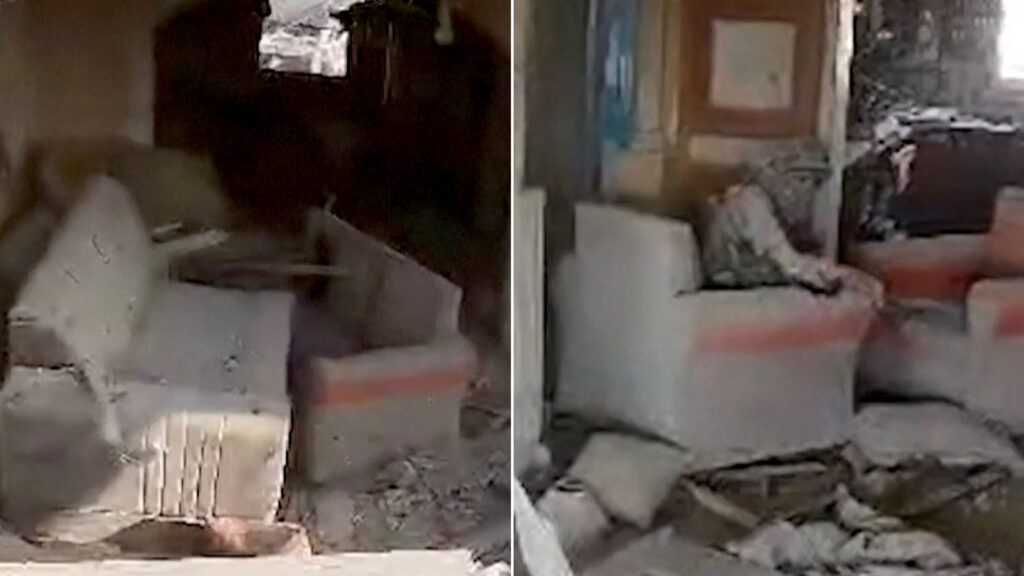10/19/2024–|Last updated: 10/19/202410:34 PM (Mecca time)
Yesterday, Friday, the Israeli occupation army published what it said were the last moments of the head of the political bureau of the Islamic Resistance Movement (Hamas), Yahya Sinwar, after he was martyred following clashes with the occupation forces in the city of Rafah, south of the Gaza Strip, the day before yesterday, Wednesday.
Al-Sinwar appeared in the clip, sitting on a chair, wearing a keffiyeh, and his right hand was injured. However, he carried a stick and threw it at the Israeli drone that was sent to photograph him.
For many decades, our nation has been asking: Where is Saladin? When he came to her seeking, she left him alone until he met his Lord, approaching without retreating, and a few hundred meters away stood an army of a million men claiming to be from Saladin’s nation! pic.twitter.com/lAWo9abumr
– 🇵🇸 Adham Abu Salamiya (@AdhamPal922) October 18, 2024
This scene has become an icon among the pioneers of the virtual world around the world, and tweeters linked it to the last scene of the movie Omar Al-Mukhtar, and how the genius of the international director Mustafa Al-Akkad was revealed. When the sheikh of the Mujahideen was executed, his glasses fell off, then a child climbed to the execution platform and picked them up, and here was Al-Akkad’s message that resistance is an idea. It does not die with the death of its leaders, and that generations will come to carry the banner.
Tweeters believe that the last scene in the life of the martyr Sinwar carried the same message and meaning, which is that the resistance does not end and that he continued to resist until his last breath.
#Yahya_Al-Sanwar You are the one who spent your life drawing the last scene of your life.
Your throne, on which you were a king, with which you exposed other kings, and the pure dust on your body with which you exposed princes who accepted injustice.
With your thoughts and your flood, you charted the path to liberating Palestine and worshiped it with your testimony.
Congratulations on this ending
Today the thorns are gone, and the cloves have begun #Palestine pic.twitter.com/KphLJRLSyw– Raad_Ra’ad (@Raad0Alnasser) October 18, 2024
Activists confirmed that Yahya Al-Sinwar was not afraid of death, but was looking for martyrdom in Gaza. He fought bravely until he breathed his last on the battlefield. His fate – beautifully depicted in the final scene – will not deter anyone from continuing the battle, but rather will become a source of inspiration for all resistance fighters in the region, Palestinians and non-Palestinians.
A conclusion that has not left me and still accompanies me.
Who arranged the end scene and conclusion of the martyr #Yahya_Al-Sanwar He alone is God, the Most High, the Almighty, the Wise, the All-Knowing, the All-Aware of us and the sincerity of our intentions. There is no doubt that this contains great wisdom and a very clear and significant message that our Lord, Glory be to Him, wanted.
The martyr’s contribution to it was through…
– Maher Chawich 🇵🇸 (@ChawichMaher) October 19, 2024
One of the tweeters said, “I did not stop for a moment to think about the drone scene. A man sits alone, wounded, facing his last moments, away from all eyes, and without the slightest reason to believe that anyone will see what he will do, refusing that the final scene be anything other than a scene of complete disobedience.” A scene of non-surrender, in a way that might be seen as an exaggeration if shown in a movie.
The writer added, “The moments before the end are moments in which the mind stops working, and instinct takes over the limbs. Showing panic and seeking to find a way out is what human instinct will dictate to them in a situation like this.”
But Sinwar did not obey his instinct, and this is impossible, unless he possesses convictions whose roots extend deeper than the instinct itself. Convictions that can curb instinct itself. The ending scene that we saw is impossible without absolute faith in what he lived for, and absolute faith in what he knows awaits him.
All that remains in that final scene is the eye: the eye of the masked man with his people’s keffiyeh stares into the camera eye of a featureless robot, and the spectator’s eye stares at this mutual stare: between a lone warrior bloodied in his land and the camera of the monster robot, between a human eye and a technical eye, the first brave, sad, and bid farewell to our world. And the second one has no head…
— Tarek Alali (@tarequealali) October 19, 2024
Commenting on the last scene of the head of the Hamas movement, one of the bloggers wrote, saying: Al-Sinwar confronting the “quad-captor” technology with a stake after leading the largest and most complex operation in the history of the resistance while surrounded by armies of Muslims is something that does not call for pride, but rather sadness for the amount of disappointment that surrounded him. We have been calling for years. Where is Saladin? When he came, we left him and his people to die alone.
One of the tweeters responded to this saying that the scene calls for pride for him alone.. It calls for pride for his family and his descendants.. It calls for pride for those crouching and stationed with him.. It calls for pride for the patient people around him.. He is their friend and they are his followers.
The scene calls for pride for him alone.. It calls for pride for his family and his descendants.. It calls for pride for those who crouched and stationed with him.. It calls for pride for the patient people around him.. He is his owner and they are his followers..
What do we, the neglectful ones, have to do with his pride?– Ghalyan (@ghalayaan) October 19, 2024

